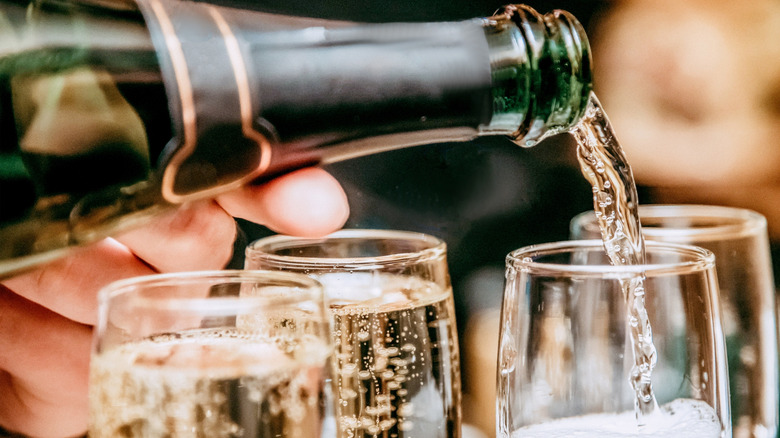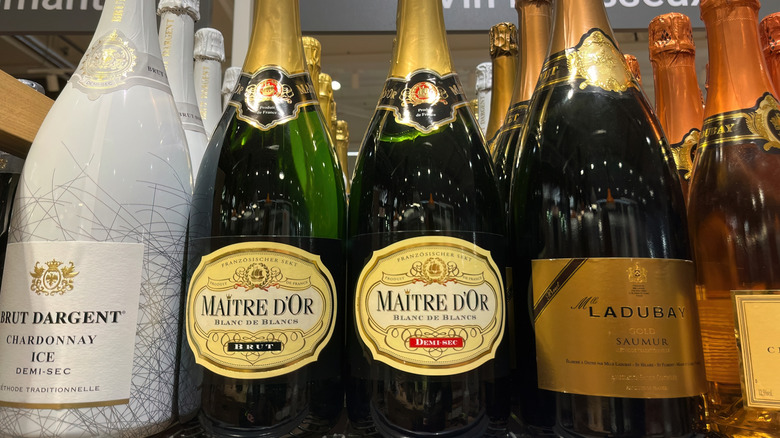How To Tell If A Sparkling Wine Is Dry Or Sweet
Although many sparkling wines look similar when poured into a glass, the reality is that this delightfully bubbly beverage comes in a variety of flavors and levels of sweetness. For the novice, it can be difficult to determine if what's in your hand at the wine store is sweet or dry (dry simply means "not sweet"). There are some key words to look for on the label of any given sparkling wine that will help you choose one that you'll love.
Because there are several kinds of sparkling wines on the market, the wording on labels can vary widely. For example, some of the terms used to describe the sugar or lack thereof in a bottle of Champagne will differ from a bottle of Spanish cava or Italian prosecco. With Champagne, the driest you can get will be indicated with the words "brut nature" or "brut zero." Extra brut denotes the next level of dryness, followed by brut, extra dry, dry, demi-sec, and doux, which is the sweetest type of Champagne you can get. So, if you like a good balance of sweet and dry in your Champagne, one labeled as "extra dry" will put you right in the middle of the dry-sweet scale.
Cava wines share some of the French terminology used for Champagnes. From driest to sweetest on the Spanish equivalent, look for brut nature, extra brut, brut, extra seco, seco, semi-seco, and dulce. From driest to sweetest, prosecco from Italy is identical to Champagne in its descriptors save for the sweetest, which is called dolce.
What makes sparkling wine sweet?
Of course, the world of sparkling wines includes more than just Champagne, cava, and prosecco, though these are very popular styles. Spumante wines are Italian bubbly wines that don't follow the same regulations as prosecco, but they use the same terminology to indicate their dry or sweet level. Some examples include Asti spumante and moscato d'Asti, both of which are sweet sparkling wines from Italy, though there are plenty of spumante wines on the dry side.
How dry or sweet a sparkling wine becomes is largely dependent on the types of grapes it is made with and the dosage– the wine-sugar blend that winemakers add to their sparkling wines. For example, those made with muscat grapes, like the aforementioned moscato d'Asti, are generally sweeter. Meanwhile, those made from chardonnay grapes (like blanc de blanc Champagne) tend to be relatively dry.
Because sparkling wines can be very acidic, dosage is very commonly added to balance out any extreme tartness or to intentionally make the wine sweeter. In addition, dosage can affect the bouquet (or aroma) of a wine as well as the texture, or mouthfeel. A doux Champagne, for example, will end up with 50 grams or more of residual sugar per liter, whereas an extra brut will have 6 grams or less. Brut nature sparkling wines are the only type that doesn't undergo dosage at all, though they do still naturally have some residual sugar.
How much sugar do you like in your bubbly?
If you're totally new to wine in general, the question might become, "Do I like sweet or dry sparkling wine?" You may need to try a few different styles to find your preference, but if you already have an idea of how you tend to like your wines, it's a little easier to shop for a bubbly. If you like something dry and refreshing, you'd probably enjoy a brut-style sparkler. If bone-dry is not your thing, but you don't necessarily go for sweet wines, try something dry or extra dry, which should offer some excellent, juicy fruit flavors and refreshing bubbles without syrupy sweetness. And if you don't like wine unless it tastes like fruit juice, opt for something like an Asti spumante or a cava dulce.
When it comes to pairing food with sparkling wine, any style can taste lovely with the right flavors and textures, and there is a vast world of recommendations from experts on perfect pairings. In general, glasses of dry bubbly complement fried foods like chicken and french fries, plus creamy cheeses, sushi, and salty treats from the ocean like oysters and expensive caviar. Moderately sweet sparkling wines are very versatile with salads, charcuterie boards, seafood pastas, and pizza. And the sweetest wines will enhance not only spicy foods but chocolate and fruit desserts as well.


